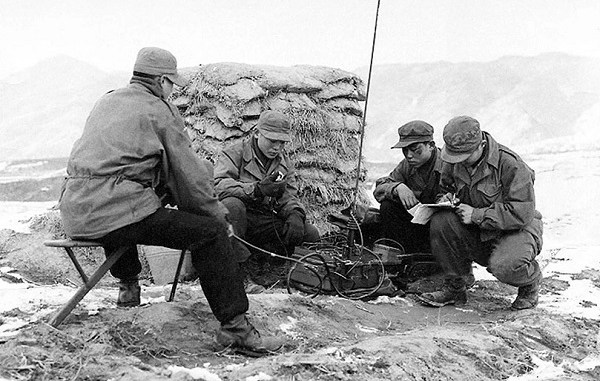
By Erin Thompson.
On 23 January 1951, Col. John H. McGee and Maj. William A. Burke of the Eighth Army (EUSA) G-3 submitted a report to the United Nations Far East Command (FEC) recommending the use of North Korean anti-communist guerrillas for intelligence gathering and sabotage missions behind the 38th parallel. This report led to the formation of the United Nations Partisan Forces Korea (UNPFK).
The Army’s early forays into organized special warfare came about over a need to perform reconnaissance and sabotage operations behind the 38th parallel. The Army encountered the North Korean partisans during the retreat from the Chinese Communist Force (CCF) invasion in late 1950. Many of these guerrillas had moved to the hillsides to escape being drafted into the North Korean People’s Army (NKPA) in the late 1940s. They quickly gained sympathizers among the villages, raided NKPA encampments, stole Soviet and Chinese weapons, arranged for the spreading of propaganda, and actively recruited from the nearby villages.
Colonel (later Brig. Gen.) McGee was a veteran of World War II, where he served with the 45th Infantry Scouts training indigenous troops on Mindanao, Philippines. After two years as a prisoner of war in Japan, McGee escaped a prison transport ship in 1944 and became involved with and eventually commanded a unit of Filipino guerrillas. At the start of the Korean conflict, he was working under EUSA G-3. Since gathering intelligence behind the 38th parallel often required the resources and personnel of the G-3, Colonel McGee’s involvement with unconventional and covert warfare consistently found him performing tasks under the umbrella of both G-2 and G-3 control. From his previous experience working with guerrillas, McGee believed the partisans could secure valuable intelligence behind enemy lines.
In early January 1951, FEC permitted McGee to establish the partisans as an organized force under Eighth Army command. Operating under EUSA G-3, Miscellaneous Division, the “Attrition Section,” as it became known, initially employed only one officer: McGee. He was joined a week later by FEC G-3 Executive Officer Maj. William A. Burke. Burke took McGee’s early plans for guerrilla operations and began refining them into a formal report for the Attrition Section under a mixed EUSA/FEC coordination. On 23 January 1951, Major Burke submitted Plan ABLE to Eighth Army command, recommending the use of partisans in performing intelligence and sabotage missions. This plan, known later as Operational Plan One, became the basis for the organization of all UNPFK activities during the Korean War.
Plan ABLE called for guerrillas to be trained in areas of intelligence gathering, communications, demolitions, and basic infantry tactics. It outlined the organization of partisan units and command structure and outlined west coast areas of operations. East coast and potential airborne operations were expected to begin in March. [See “This Week in MI History” #177 15 March 1951] Above all, Plan ABLE anticipated the partisans would be useful for the UN’s planned counteroffensive in mid-1951 to push CCF and NKPA troops north of the 38th parallel and called for recruitment of more guerrillas to assist with the operation.
The efforts of UNPFK were consistently hampered by command structures, as commanders like McGee were placed under Army G-3 while operational control remained under FEC G-2. Staff elements would consistently be moved and reorganized throughout the remainder of the war. Despite this, partisans showed proven successes in their ability to infiltrate enemy encampments, disrupt enemy communications, collect maps and documents for EUSA and FEC intelligence, and perform sabotage missions against NKPA bridges, tunnels, and bases.
****
This story, “Guerrillas Recommended for Intelligence & Sabotage Work (23 Jan 1951)“, by Erin Thompson of the U.S. Army Intelligence Center of Excellence was originally published by the Defense Visual Information Distribution Service on January 19, 2024. DVIDS content is in the public domain.
Photo: UNPFK Guerrillas with AN/GRC-9. (DVIDS)